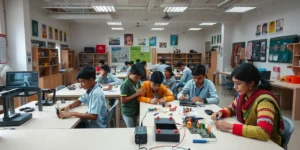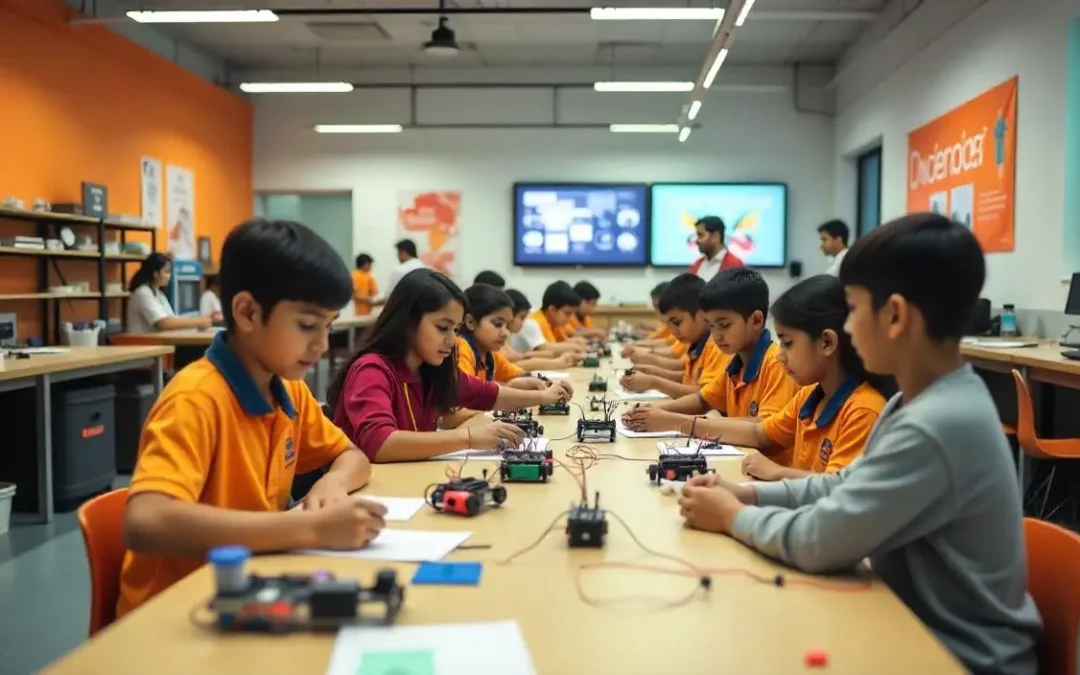Our nation is on the brink of a major transformation in education and innovation. In a bold move to foster creativity and scientific temperament among students, the central government has announced plans to establish 50,000 new Atal Tinkering Labs across the country over the next five years. This initiative is set to revolutionize the way young minds approach learning, shifting from rote memorization to hands-on experimentation and problem-solving
With a strong emphasis on STEM (Science, Technology, Engineering, and Mathematics) education, Atal Tinkering Labs will equip students with the necessary skills to thrive in a rapidly evolving technological landscape. This initiative aligns with India’s broader vision of becoming a global innovation hub by nurturing the next generation of scientists, engineers, and entrepreneurs.
What Are Tinkering Labs?
Tinkering labs are creative workspaces designed to encourage students to experiment, invent, and build projects using cutting-edge technologies such as robotics, artificial intelligence (AI), 3D printing, and the Internet of Things (IoT). These labs provide an open environment where young learners can test their ideas, solve real-world problems, and develop a maker’s mindset.
They are typically equipped with:
- Electronics and circuit boards
- Mechanical tools and 3D printers
- Coding and robotics kits
- IoT and AI learning modules
- Virtual reality (VR) and augmented reality (AR) tools
By exposing students to such technologies at an early stage, Atal Tinkering Labs play a vital role in bridging the gap between theoretical knowledge and practical application
The Government’s Vision: Why 50,000 Labs?
The Indian government, through organizations like Atal Innovation Mission (AIM) under NITI Aayog, has been actively promoting innovation-driven learning. With over 10,000 Atal Tinkering Labs (ATLs) already established, the plan to add 50,000 more aims to extend this impact to every corner of the country.
Key Objectives of the Initiative:
- Encouraging Innovation: Empower students to develop problem-solving skills through hands-on projects.
- Bridging the Digital Divide: Provide access to advanced technology in schools across urban and rural areas.
- Boosting Entrepreneurship: Foster an entrepreneurial mindset by enabling students to transform ideas into working prototypes.
- Enhancing STEM Learning: Make STEM education more interactive and engaging, leading to a better understanding of concepts.
- Preparing for Future Careers: Equip students with 21st-century skills required for emerging industries like AI, robotics, and automation.
This large-scale expansion of Atal Tinkering Labs will create a more inclusive ecosystem, ensuring that even students in remote areas have access to the same learning opportunities as those in metropolitan cities

atal tinkering labs
Impact on Students and Schools
The introduction of 50,000 Atal Tinkering Labs will redefine the learning experience for millions of students across India. Instead of relying solely on textbooks, students will explore, invent, and collaborate, making learning more engaging and effective
How Students Will Benefit:
- Hands-on Learning: Practical exposure to AI, coding, robotics, and IoT will deepen understanding.
- Confidence Building: Creating projects from scratch will enhance critical thinking and creativity.
- Teamwork & Collaboration: Working on real-world challenges will improve communication and leadership skills.
- Career Readiness: Exposure to futuristic technologies will prepare students for high-demand careers.
- Global Competitiveness: Indian students will be better positioned to compete in the global innovation landscape.
For schools, integrating Atal Tinkering Labs means upgrading their educational approach. Institutions adopting this experiential learning model will gain a competitive edge, attracting students and parents looking for modern education methodologies
Bridging the Urban-Rural Divide
One of the biggest advantages of this initiative is its potential to democratize access to technology. Many schools in rural India lack modern infrastructure and learning resources. By setting up Atal Tinkering Labs in these areas, the government ensures that students from underprivileged backgrounds also get equal opportunities to innovate and excel
This initiative will unleash untapped potential by:
- Providing high-tech resources to rural schools
- Encouraging students to think beyond traditional careers
- Connecting rural innovators to mentors and industry leaders
- Promoting local innovations that solve grassroots problems
Challenges & How to Overcome Them
While the initiative is ambitious and promising, its success will depend on effective implementation. Some challenges that may arise include:
- Infrastructure & Maintenance: Setting up and maintaining 50,000 labs requires substantial investment and resources.
Solution: A public-private partnership model can help share financial and operational responsibilities.
- Teacher Training: Many educators lack the technical expertise to guide students in advanced technology projects.
Solution: Conducting regular teacher training programs to ensure they are equipped with the right skills.
- Awareness & Adoption: Schools and parents might hesitate to embrace new learning methods.
Solution: Running awareness campaigns showcasing success stories from existing tinkering labs.
By addressing these challenges proactively, the government can ensure the long-term success of this initiative.
A Step Towards an Innovative India
The plan to set up 50,000 Atal Tinkering Labs in the next five years is a game-changer for India’s education system. It signifies a shift from passive learning to active exploration, paving the way for a future generation of innovators, problem-solvers, and entrepreneurs. Composite lab and skill laboratory setups will further complement this initiative by providing diverse learning environments that enhance practical skills and interdisciplinary knowledge
This initiative will not only prepare students for high-tech careers but also contribute to India’s vision of becoming a global technology leader. By fostering a culture of innovation from an early age, these labs will empower young minds to shape the future of science and technology. Design & Technology Lab setup for CBSE Schools will further enhance this vision by providing modern infrastructure and resources to support experiential learning and creativity
India is ready for its next big innovation revolution—and it starts in the classrooms of today.

